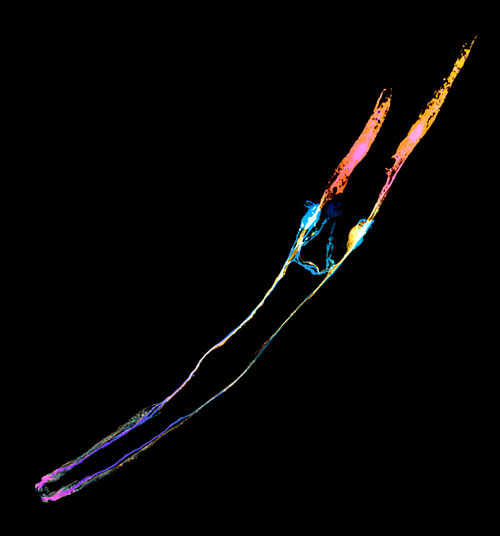From neuroscience textbooks, we learn that neurons are individual cells which communicate with each other through chemical or electrical synapses, excluding the process of cell-cell fusion from the normal development and function of the nervous system. In this study, we show that expression of fusogens in individual neurons results in neuronal fusion, leading to the shortcut of neural circuits and ultimately altered animal behaviour. We propose that misexpression of fusogens and neuronal fusion might represent an underlying and still underappreciated cause of neurological disease.

Figure 1: While the majority of neurons are individual cells, as proposed by the theory of Ramón y Cajal, some neurons have undergone fusion, as previously suggested by Camilo Golgi. Using C. elegans as a model system, we show that ectopic expression of fusogens in the nervous system leads to cell-cell fusion between neurons and between neurons and glia. Fused neurons are functional and retain their original neuronal fate, however they become electrically coupled causing a shortcut of neural circuits and resulting in altered animal behaviour. Image credit: Rosina Giordano-Santini and Nick Valmas.
The 100-year-old theory of Ramón y Cajal states that neurons are single cells, which connect with other neurons through specialized structures called synapses. This is in contrast to the theory of Camilo Golgi, who defined the nervous system as a reticulum of cells, all linked through membrane and cytoplasmic continuity. Over the years, researchers have confirmed Ramón y Cajal’s theory in every model organism studied, excluding the process of cell-cell fusion from the normal development and function of the nervous system. However, accumulating evidence shows that neurons can undergo cell-cell fusion under certain conditions of stress, viral infection and some neurological diseases, and that fusogens (proteins required for the merging of plasma membranes during the process of cell-cell or virus-cell fusion) are present in the nervous system in such conditions. Despite this compelling evidence, very little is known about whether the presence of fusogens can lead to neuronal cell-cell fusion, and, if so, what are the in vivo consequences of such a reticulum.

Figure 2: A colorized confocal image of fused chemosensory neurons and glia cells in the head of a Caenorhabditis elegans at the dauer stage. Image credit: Fiona Ritchie and Nick Valmas.
The study of these questions has been hindered by the complexity of the vertebrate nervous system, where it is particularly difficult to manipulate the expression of fusogens in single cells, to find eventual fusion events among billions of highly arborized interconnected neurons, and to link these events to specific behavioural outputs. To overcome these difficulties, we took advantage of the nervous system of the nematode Caenorhabditis elegans, which contains only 302 neurons. This model organism can be genetically manipulated at the level of single neurons and the function of individual neurons can be linked to specific behaviours.
We expressed the nematode fusogen Epithelial Fusion Failure - 1 (EFF-1) in the neurons of the C. elegans olfactory organ and observed fusion of chemosensory neurons occurring between their axons. By specifically manipulating the expression of EFF-1 in subsets of neurons, we were able to specifically fuse two chemoattractive neurons, and found that they remained functional and were able to mediate attraction to odorants. We then fused chemoattractive neurons with chemorepulsive neurons. Remarkably, the neurons remained viable and continued expressing their original neuronal markers, but animals with fused neurons lost the ability to locate the source of attractants, or to escape from the source of repellents. Calcium imaging experiments revealed that fused neurons remained functional and able to detect odorants, but fusion resulted in the connection of the otherwise separate attraction and repulsion neural circuits, causing neural circuit shortcut and altered animal behaviour.
These proof-of-principle experiments provide evidence that neurons can undergo cell-cell fusion following the abnormal expression of fusogens, and that while fusion of neurons of the same modality might not have major consequences, fusion of neurons of different modality and from separate neural circuits leads to circuit rewiring and altered animal behaviour. The extent to which fusogens expose neurons to cell-cell fusion in humans remains unknown, but based on compelling evidence it is tempting to speculate that this could be the basis of a number of neurological diseases and an additional deleterious effect of viral infections.


































